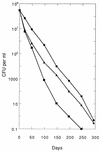A mixed culture recovery method indicates that enteric bacteria do not enter the viable but nonculturable state
- PMID: 9572945
- PMCID: PMC106224
- DOI: 10.1128/AEM.64.5.1736-1742.1998
A mixed culture recovery method indicates that enteric bacteria do not enter the viable but nonculturable state
Abstract
A new method, called the mixed culture recovery (MCR) method, has been developed to determine whether recovery of culturable bacterial cells from a population of largely nonculturable cells is due to resuscitation of the nonculturable cells from a viable but nonculturable state or simply to growth of residual culturable cells. The MCR method addresses this issue in that it involves the mixing of two easily distinguishable strains (e.g., lactose positive and negative) in such a way that large numbers of nonculturable cells of both strains are present together with a small number of culturable cells of only one strain, performing a nutrient addition resuscitation procedure, and then plating the cells to determine whether both cell types are recoverable. In repeated experiments with strains of Escherichia coli, Klebsiella pneumoniae, Enterococcus faecalis, Enterobacter aerogenes, and Salmonella choleraesuis, only cells of the culturable strain were recovered after application of various resuscitation techniques. These results suggest that the nonculturable cells were dead and that the apparent resuscitation was merely due to the growth of the remaining culturable cells.
Figures


References
-
- Bachmann B J. Derivations and genotypes of some mutant derivatives of Escherichia coli K-12. In: Neidhardt F C, Ingraham J L, Low K B, Magasanik B, Schaechter M, Umbarger H E, editors. Escherichia coli and Salmonella typhimurium: cellular and molecular biology. Washington, D.C: American Society for Microbiology; 1987. pp. 1190–1219.
-
- Barer M R, Gribbon L T, Harwood C R, Nwoguh C E. The viable but nonculturable hypothesis and medical bacteriology. Rev Med Microbiol. 1993;4:183–191.
MeSH terms
Substances
LinkOut - more resources
Full Text Sources

